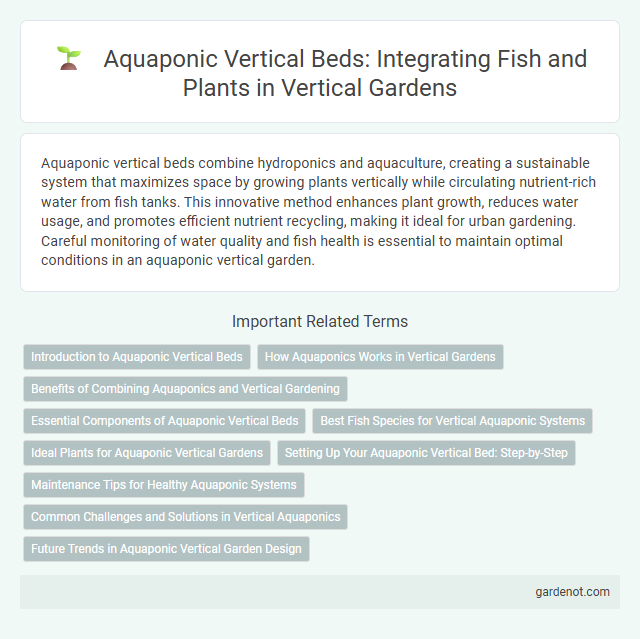Aquaponic vertical beds combine hydroponics and aquaculture, creating a sustainable system that maximizes space by growing plants vertically while circulating nutrient-rich water from fish tanks. This innovative method enhances plant growth, reduces water usage, and promotes efficient nutrient recycling, making it ideal for urban gardening. Careful monitoring of water quality and fish health is essential to maintain optimal conditions in an aquaponic vertical garden.
Introduction to Aquaponic Vertical Beds
Aquaponic vertical beds combine aquaculture and hydroponics in a space-efficient structure, allowing fish and plants to mutually benefit through nutrient cycling. These systems optimize water usage by recirculating nutrient-rich fish water to nourish plants grown vertically, increasing yield per square foot. Aquaponic vertical beds are ideal for urban agriculture, enhancing sustainability by reducing water consumption and eliminating the need for chemical fertilizers.
How Aquaponics Works in Vertical Gardens
Aquaponics in vertical gardens integrates fish farming and hydroponic plant cultivation within a closed-loop system, where fish waste provides essential nutrients for plants. The water, enriched with nitrogen and other minerals from fish excrement, circulates through vertical beds, feeding roots and promoting rapid plant growth without soil. This efficient synergy conserves water, maximizes space, and supports sustainable food production in urban environments.
Benefits of Combining Aquaponics and Vertical Gardening
Aquaponic vertical beds enhance space efficiency by integrating fish farming with hydroponic plant cultivation, creating a sustainable nutrient cycle that minimizes water usage by up to 90% compared to traditional gardening. This synergy boosts plant growth rates through natural fertilization from fish waste, reducing the need for chemical fertilizers and promoting organic production. The system's vertical structure maximizes yield per square foot, making it ideal for urban environments and small-scale farming with limited space.
Essential Components of Aquaponic Vertical Beds
Essential components of aquaponic vertical beds include a durable vertical structure, a water circulation system, and a growth medium that supports both plants and nitrifying bacteria. The system incorporates fish tanks supplying nutrient-rich water, which is pumped through grow beds where plants absorb nutrients while biofilters convert fish waste into beneficial compounds. Proper aeration, filtration units, and plumbing ensure optimal water quality and circulation for sustainable, high-yield vertical farming.
Best Fish Species for Vertical Aquaponic Systems
Tilapia, catfish, and koi are among the best fish species for vertical aquaponic systems due to their adaptability to varying water conditions and efficient growth rates. These species thrive in recirculating aquaponic environments, providing optimal nutrient cycling for vertical garden beds. Selecting fast-growing, hardy fish enhances system sustainability and maximizes plant productivity in vertical aquaponic setups.
Ideal Plants for Aquaponic Vertical Gardens
Aquaponic vertical gardens thrive with herbs like basil, mint, and oregano due to their adaptability and fast growth in nutrient-rich water. Leafy greens such as lettuce, spinach, and kale also perform exceptionally well, benefiting from the consistent moisture and oxygenation in aquaponic systems. Compact fruiting plants like cherry tomatoes and strawberries can be integrated successfully, maximizing space while leveraging the efficient nutrient cycling inherent in aquaponic vertical beds.
Setting Up Your Aquaponic Vertical Bed: Step-by-Step
Setting up your aquaponic vertical bed begins with selecting a sturdy frame designed to support water flow and plant growth. Integrate a reliable water pump and filtration system to maintain nutrient-rich water circulation between fish tanks and planting beds. Establish seedling trays or grow media that promote root aeration while ensuring consistent moisture for healthy aquaponic plant development.
Maintenance Tips for Healthy Aquaponic Systems
Regular monitoring of water quality, including pH, ammonia, nitrate, and temperature levels, is crucial for maintaining a healthy aquaponic vertical bed. Consistent cleaning of filters and removal of debris prevents system blockages and promotes optimal nutrient cycling for plant and fish health. Balancing fish feeding with plant nutrient uptake ensures efficient waste conversion, supporting robust growth in both aquatic organisms and vertical garden plants.
Common Challenges and Solutions in Vertical Aquaponics
Aquaponic vertical beds often face challenges such as nutrient imbalances, water circulation issues, and root space limitations that can hinder plant growth and fish health. Effective solutions include regularly monitoring water parameters to maintain optimal nutrient levels, employing high-efficiency pumps to ensure consistent water flow, and designing vertical beds with sufficient depth and aeration to support robust root development. Implementing biofiltration systems and selecting resilient plant species also contribute to overcoming these common obstacles in vertical aquaponics.
Future Trends in Aquaponic Vertical Garden Design
Aquaponic vertical garden design is evolving with innovations that enhance water efficiency and nutrient cycling, integrating advanced IoT sensors for real-time monitoring of plant health and fish conditions. Emerging trends emphasize modular, scalable systems using renewable energy sources like solar power to reduce environmental impact and operational costs. Future aquaponic vertical beds will likely incorporate AI-driven automation for optimized resource management and higher crop yields, revolutionizing urban agriculture sustainability.
Aquaponic vertical bed Infographic

 gardenot.com
gardenot.com